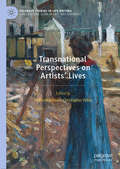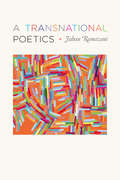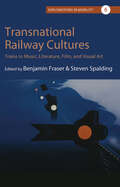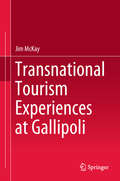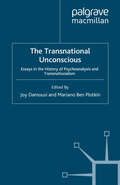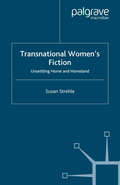- Table View
- List View
Transnational Perspectives on Artists’ Lives: From The Nineteenth Century To The Present (Palgrave Studies in Life Writing)
by Marleen Rensen Christopher WileyThis book demonstrates the significance of transnationality for studying and writing the lives of artists. While painters, musicians and writers have long been cast as symbols of their associated nations, recent research is increasingly drawing attention to those aspects of their lives and works that resist or challenge the national framework. The volume showcases different ways of treating transnationality in life writing by and about artists, investigating how the transnational can offer intriguing new insights on artists who straddle different nations and cultures. It further explores ways of adopting transnational perspectives in artists’ biographies in order to deal with experiences of cultural otherness or international influences, and analyses cross-cultural representations of artists in biography and biofiction. Gathering together insights from biographers and scholars with expertise in literature, music and the visual arts, Transnational Perspectives on Artists’ Lives opens up rich avenues for researching transnationality in the cultural domain at large.
Transnational Perspectives on Graphic Narratives: Comics at the Crossroads
by Daniel Stein Shane Denson Christina MeyerThis book brings together an international group of scholars who chart and analyze the ways in which comic book history and new forms of graphic narrative have negotiated the aesthetic, social, political, economic, and cultural interactions that reach across national borders in an increasingly interconnected and globalizing world. Exploring the tendencies of graphic narratives - from popular comic book serials and graphic novels to manga - to cross national and cultural boundaries, Transnational Perspectives on Graphic Narratives addresses a previously marginalized area in comics studies. By placing graphic narratives in the global flow of cultural production and reception, the book investigates controversial representations of transnational politics, examines transnational adaptations of superhero characters, and maps many of the translations and transformations that have come to shape contemporary comics culture on a global scale.
Transnational Perspectives on Graphic Narratives: Comics at the Crossroads
by Daniel Stein Shane Denson Christina MeyerThis book brings together an international group of scholars who chart and analyze the ways in which comic book history and new forms of graphic narrative have negotiated the aesthetic, social, political, economic, and cultural interactions that reach across national borders in an increasingly interconnected and globalizing world. Exploring the tendencies of graphic narratives - from popular comic book serials and graphic novels to manga - to cross national and cultural boundaries, Transnational Perspectives on Graphic Narratives addresses a previously marginalized area in comics studies. By placing graphic narratives in the global flow of cultural production and reception, the book investigates controversial representations of transnational politics, examines transnational adaptations of superhero characters, and maps many of the translations and transformations that have come to shape contemporary comics culture on a global scale.
A Transnational Poetics
by Jahan RamazaniPoetry is often viewed as culturally homogeneous—“stubbornly national,” in T. S. Eliot’s phrase, or “the most provincial of the arts,” according to W. H. Auden. But in A Transnational Poetics, Jahan Ramazani uncovers the ocean-straddling energies of the poetic imagination—in modernism and the Harlem Renaissance; in post–World War II North America and the North Atlantic; and in ethnic American, postcolonial, and black British writing. Cross-cultural exchange and influence are, he argues, among the chief engines of poetic development in the twentieth and twenty-first centuries. Reexamining the work of a wide array of poets, from Eliot, Yeats, and Langston Hughes to Elizabeth Bishop, Lorna Goodison, and Agha Shahid Ali, Ramazani reveals the many ways in which modern and contemporary poetry in English overflows national borders and exceeds the scope of national literary paradigms. Through a variety of transnational templates—globalization, migration, travel, genre, influence, modernity, decolonization, and diaspora—he discovers poetic connection and dialogue across nations and even hemispheres.
A Transnational Poetics
by Jahan RamazaniPoetry is often viewed as culturally homogeneous—“stubbornly national,” in T. S. Eliot’s phrase, or “the most provincial of the arts,” according to W. H. Auden. But in A Transnational Poetics, Jahan Ramazani uncovers the ocean-straddling energies of the poetic imagination—in modernism and the Harlem Renaissance; in post–World War II North America and the North Atlantic; and in ethnic American, postcolonial, and black British writing. Cross-cultural exchange and influence are, he argues, among the chief engines of poetic development in the twentieth and twenty-first centuries. Reexamining the work of a wide array of poets, from Eliot, Yeats, and Langston Hughes to Elizabeth Bishop, Lorna Goodison, and Agha Shahid Ali, Ramazani reveals the many ways in which modern and contemporary poetry in English overflows national borders and exceeds the scope of national literary paradigms. Through a variety of transnational templates—globalization, migration, travel, genre, influence, modernity, decolonization, and diaspora—he discovers poetic connection and dialogue across nations and even hemispheres.
A Transnational Poetics
by Jahan RamazaniPoetry is often viewed as culturally homogeneous—“stubbornly national,” in T. S. Eliot’s phrase, or “the most provincial of the arts,” according to W. H. Auden. But in A Transnational Poetics, Jahan Ramazani uncovers the ocean-straddling energies of the poetic imagination—in modernism and the Harlem Renaissance; in post–World War II North America and the North Atlantic; and in ethnic American, postcolonial, and black British writing. Cross-cultural exchange and influence are, he argues, among the chief engines of poetic development in the twentieth and twenty-first centuries. Reexamining the work of a wide array of poets, from Eliot, Yeats, and Langston Hughes to Elizabeth Bishop, Lorna Goodison, and Agha Shahid Ali, Ramazani reveals the many ways in which modern and contemporary poetry in English overflows national borders and exceeds the scope of national literary paradigms. Through a variety of transnational templates—globalization, migration, travel, genre, influence, modernity, decolonization, and diaspora—he discovers poetic connection and dialogue across nations and even hemispheres.
A Transnational Poetics
by Jahan RamazaniPoetry is often viewed as culturally homogeneous—“stubbornly national,” in T. S. Eliot’s phrase, or “the most provincial of the arts,” according to W. H. Auden. But in A Transnational Poetics, Jahan Ramazani uncovers the ocean-straddling energies of the poetic imagination—in modernism and the Harlem Renaissance; in post–World War II North America and the North Atlantic; and in ethnic American, postcolonial, and black British writing. Cross-cultural exchange and influence are, he argues, among the chief engines of poetic development in the twentieth and twenty-first centuries. Reexamining the work of a wide array of poets, from Eliot, Yeats, and Langston Hughes to Elizabeth Bishop, Lorna Goodison, and Agha Shahid Ali, Ramazani reveals the many ways in which modern and contemporary poetry in English overflows national borders and exceeds the scope of national literary paradigms. Through a variety of transnational templates—globalization, migration, travel, genre, influence, modernity, decolonization, and diaspora—he discovers poetic connection and dialogue across nations and even hemispheres.
A Transnational Poetics
by Jahan RamazaniPoetry is often viewed as culturally homogeneous—“stubbornly national,” in T. S. Eliot’s phrase, or “the most provincial of the arts,” according to W. H. Auden. But in A Transnational Poetics, Jahan Ramazani uncovers the ocean-straddling energies of the poetic imagination—in modernism and the Harlem Renaissance; in post–World War II North America and the North Atlantic; and in ethnic American, postcolonial, and black British writing. Cross-cultural exchange and influence are, he argues, among the chief engines of poetic development in the twentieth and twenty-first centuries. Reexamining the work of a wide array of poets, from Eliot, Yeats, and Langston Hughes to Elizabeth Bishop, Lorna Goodison, and Agha Shahid Ali, Ramazani reveals the many ways in which modern and contemporary poetry in English overflows national borders and exceeds the scope of national literary paradigms. Through a variety of transnational templates—globalization, migration, travel, genre, influence, modernity, decolonization, and diaspora—he discovers poetic connection and dialogue across nations and even hemispheres.
A Transnational Poetics
by Jahan RamazaniPoetry is often viewed as culturally homogeneous—“stubbornly national,” in T. S. Eliot’s phrase, or “the most provincial of the arts,” according to W. H. Auden. But in A Transnational Poetics, Jahan Ramazani uncovers the ocean-straddling energies of the poetic imagination—in modernism and the Harlem Renaissance; in post–World War II North America and the North Atlantic; and in ethnic American, postcolonial, and black British writing. Cross-cultural exchange and influence are, he argues, among the chief engines of poetic development in the twentieth and twenty-first centuries. Reexamining the work of a wide array of poets, from Eliot, Yeats, and Langston Hughes to Elizabeth Bishop, Lorna Goodison, and Agha Shahid Ali, Ramazani reveals the many ways in which modern and contemporary poetry in English overflows national borders and exceeds the scope of national literary paradigms. Through a variety of transnational templates—globalization, migration, travel, genre, influence, modernity, decolonization, and diaspora—he discovers poetic connection and dialogue across nations and even hemispheres.
Transnational Politics in the Post-9/11 Novel (Routledge Research in American Literature and Culture)
by Joseph ConteTransnational Politics in the Post-9/11 Novel suggests that literature after September 11, 2001 reflects the shift from bilateral nation-state politics to the multilateralism of transnational politics. While much of the criticism regarding novels of 9/11 tends to approach these works through theories of personal and collective trauma, this book argues for the evolution of a post-9/11 novel that pursues a transversal approach to global conflicts that are unlikely to be resolved without diverse peoples willing to set aside sectarian interests. These novels embrace not only American writers such as Don DeLillo, Dave Eggers, Ken Kalfus, Thomas Pynchon, and Amy Waldman but also the countervailing perspectives of global novelists such as J. M. Coetzee, Orhan Pamuk, Mohsin Hamid, and Laila Halaby. These are not novels about terror(ism), nor do they seek comfort in the respectful cloak of national mourning. Rather, they are instances of the novel in terror, which recognizes that everything having been changed after 9/11, only the formally inventive presentation will suffice to acknowledge the event’s unpresentability and its shock to the political order.
Transnational Politics in the Post-9/11 Novel (Routledge Research in American Literature and Culture)
by Joseph ConteTransnational Politics in the Post-9/11 Novel suggests that literature after September 11, 2001 reflects the shift from bilateral nation-state politics to the multilateralism of transnational politics. While much of the criticism regarding novels of 9/11 tends to approach these works through theories of personal and collective trauma, this book argues for the evolution of a post-9/11 novel that pursues a transversal approach to global conflicts that are unlikely to be resolved without diverse peoples willing to set aside sectarian interests. These novels embrace not only American writers such as Don DeLillo, Dave Eggers, Ken Kalfus, Thomas Pynchon, and Amy Waldman but also the countervailing perspectives of global novelists such as J. M. Coetzee, Orhan Pamuk, Mohsin Hamid, and Laila Halaby. These are not novels about terror(ism), nor do they seek comfort in the respectful cloak of national mourning. Rather, they are instances of the novel in terror, which recognizes that everything having been changed after 9/11, only the formally inventive presentation will suffice to acknowledge the event’s unpresentability and its shock to the political order.
Transnational Portuguese Studies (Transnational Modern Languages #3)
Transnational Portuguese Studies offers a radical rethinking of the role played by the concepts of ‘nationhood’ and ‘the nation’ in the epistemologies that underpin Portuguese Studies as an academic discipline. Portuguese Studies offers a particularly rich and enlightening challenge to methodological nationalism in Modern Languages, not least because the teaching of Portuguese has always extended beyond the study of the single western European country from which the language takes its name. However, this has rarely been analysed with explicit, or critical, reference to the ‘transnational turn’ in Arts and Humanities. This volume of essays from leading scholars in Portugal, Brazil, the USA and the UK, explores how the histories, cultures and ideas constituted in and through Portuguese language resist borders and produce encounters, from the manoeuvres of 15th century ‘globalization’ and cartography to present-day mega events such as the Rio Olympics. The result is a timely counter-narrative to the workings of linguistic and cultural nationalism, demonstrating how texts, paintings and photobooks, musical forms, political ideas, cinematic representations, gender identities, digital communications and lexical forms, may travel, translate and embody transcultural contact in ways which only become readable through the optics of transnationalism.Contributors: Ana Margarida Dias Martins, Anna M. Klobucka, Christopher Larkosh, Claire Williams, Cláudia Pazos Alonso, Edward King, Ellen W. Sapega, Fernando Arenas, Hilary Owen, José Lingna Nafafé, Kimberly DaCosta Holton, Maria Luísa Coelho, Paulo de Medeiros, Sara Ramos Pinto, Sheila Moura Hue, Simon Park, Susana Afonso, Tatiana Heise, Toby Green, Tori Holmes, Vivien Kogut Lessa de Sá and Zoltán Biedermann.
Transnational Railway Cultures: Trains in Music, Literature, Film, and Visual Art (Explorations in Mobility #6)
by Benjamin Fraser Steven SpaldingSince the advent of train travel, railways have compressed space and crossed national boundaries to become transnational icons, evoking hope, dread, progress, or obsolescence in different cultural domains. Spanning five continents and a diverse range of contexts, this collection offers an unprecedentedly broad survey of global representations of trains. From experimental novels to Hollywood blockbusters, the works studied here chart fascinating routes across a remarkably varied cultural landscape.
Transnational Russian Studies (Transnational Modern Languages #1)
Transnational Russian Studies offers an approach to understanding Russia based on the idea that language, society and culture do not neatly coincide, but should be seen as flows of meaning across ever-shifting boundaries. Our book moves beyond static conceptions of Russia as a discrete nation with a singular language, culture, and history. Instead, we understand it as a multinational society that has perpetually redefined Russianness in reaction to the wider world. We treat Russian culture as an expanding field, whose sphere of influence transcends the geopolitical boundaries of the Russian Federation, reaching as far as London, Cape Town, and Tehran.Our transnational approach to Russian Studies generates new perspectives on the history of Russian culture and its engagements with, and transformation by, other cultures. The volume thereby simultaneously illuminates broader conceptions of the transnational from the perspective of Russian Studies. Over twenty chapters, we provide case studies based on original research, treating topics that include Russia’s imperial and postcolonial entanglements; the paradoxical role that language plays in both defining culture in national terms, and facilitating transnational communication; the life of things ‘Russian’ in the global arena; and Russia’s positioning in the contemporary globalized world. Our volume is aimed primarily at students and researchers in Russian Studies, but it will also be relevant to all Modern Linguists, and to those who employ transnational paradigms within the broader humanities.Contributors: Amelia M. Glaser, Cathy McAteer, Connor Doak, Dušan Radunović, Ellen Rutten, Galin Tihanov, Jeanne-Marie Jackson, Julie Curtis, Lara Ryazanova-Clarke, Marijeta Bozovic, Michael Gorham, Olga Maiorova, Philip Ross Bullock, Sergey Tyulenev, Stephen Hutchings, Stephen M. Norris, Tatiana Filimonova, Vera Tolz, Vitaly Nuriev and Vlad Strukov.
Transnational Spaces of India and Australia
by Paul Sharrad Deb Narayan BandyopadhyayTransnational movements are more intricate than diasporic conflicts of ‘home and away’. They operate not only as international connections but also transect and disturb national formations. What are the spaces (both physical and temporal) in and around which transnational exchanges occur? Much discussion of the transnational focuses on international movements of law, politics and economics as they relate to Europe and the Americas. This book extends the focus to dynamics across the humanities and social sciences and concentrates on the historical and now growing interactions between India and Australia. Studies come from scholars in both countries, who combine academic depth for students and researchers and writing that is clear and engaging for the general reader.
Transnational Spanish Studies (Transnational Modern Languages #2)
The focus of this book is two-fold. First it traces the expansive geographical spread of the language commonly referred to as Spanish. This has given rise to multiple hybrid formations over time emerging in the clash of multiple cultures, languages and religions within and between great empires (Roman, Islamic, Hispano-Catholic), each with expansionist policies leading to wars, huge territorial gains and population movements. This long history makes Hispanophone culture itself a supranational, trans-imperial one long before we witness its various national cultures being refashioned as a result of the transnational processes associated with globalization today. Indeed, the Spanish language we recognise today was ‘transnational’ long before it was ever the foundation of a single nation state. Secondly, it approaches the more recent post-national, translingual and inter-subjective ‘border-crossings’ that characterise the global world today with an eye to their unfolding within this long trans-imperial history of the Hispanophone world. In doing so, it maps out some of the contemporary post-colonial, decolonial and trans-Atlantic inflections of this trans-imperial history as manifest in literature, cinema, music and digital cultures. Contributors: Christopher J. Pountain, L.P. Harvey, James T. Monroe, Rosaleen Howard, Mark Thurner, Alexander Samson, Andrew Ginger, Samuel Llano, Philip Swanson, Claire Taylor, Emily Baker, Elzbieta Slodowska, Francisco-J. Hernández Adrián, Henriette Partzsch, Helen Melling, Conrad James and Benjamin Quarshie.
Transnational Tolstoy: Between the West and the World
by John Burt Foster Jr.Transnational Tolstoy renews and enhances our understanding of Tolstoy's fiction in the context of "World Literature," a term that he himself used in What is Art? It offers a fresh perspective on Tolstoy's fiction as it connects with writers and works from outside his Russian context, including Stendhal, Flaubert, Goethe, Proust, Lampedusa and Mahfouz. Foster provides an interlocking series of cross-cultural readings ranging from nineteenth-century Germany, France, and Italy through the rise of modernist fiction and the crisis of World War II, to the growth of a worldwide literary outlook from 1960 onward. He emphasizes Tolstoy's writings with the most consistent international resonance: War and Peace and Anna Karenina, two of the world's most compelling novels. Transnational Tolstoy also discusses a shorter work, Hadji Murad. It shares the earlier novels' historical sweep, social breadth, and subtle interplay among a large cast of characters. Along with bringing Tolstoy's gifts to bear on a Muslim protagonist, it also represents his most sustained attempt at world literature.
Transnational Tolstoy: Between the West and the World
by John Burt Foster, Jr.Transnational Tolstoy renews and enhances our understanding of Tolstoy's fiction in the context of "World Literature," a term that he himself used in What is Art? It offers a fresh perspective on Tolstoy's fiction as it connects with writers and works from outside his Russian context, including Stendhal, Flaubert, Goethe, Proust, Lampedusa and Mahfouz. Foster provides an interlocking series of cross-cultural readings ranging from nineteenth-century Germany, France, and Italy through the rise of modernist fiction and the crisis of World War II, to the growth of a worldwide literary outlook from 1960 onward. He emphasizes Tolstoy's writings with the most consistent international resonance: War and Peace and Anna Karenina, two of the world's most compelling novels. Transnational Tolstoy also discusses a shorter work, Hadji Murad. It shares the earlier novels' historical sweep, social breadth, and subtle interplay among a large cast of characters. Along with bringing Tolstoy's gifts to bear on a Muslim protagonist, it also represents his most sustained attempt at world literature.
Transnational Tourism Experiences at Gallipoli
by Jim McKayThis book offers a fresh account of the Anzac myth and the bittersweet emotional experience of Gallipoli tourists. Challenging the straightforward view of the Anzac obsession as a kind of nationalistic military Halloween, it shows how transnational developments in tourism and commemoration have created the conditions for a complex, dissonant emotional experience of sadness, humility, anger, pride and empathy among Anzac tourists. Drawing on the in-depth testimonies of travellers from Australia and New Zealand, McKay shines a new and more complex light on the history and cultural politics of the Anzac myth. As well as making a ground breaking, empirically-based intervention into the culture wars, this book offers new insights into the global memory boom and transnational developments in backpacker tourism, sports tourism and “dark” or “dissonant” tourism.
The Transnational Unconscious: Essays in the History of Psychoanalysis and Transnationalism (Palgrave Macmillan Transnational History Series)
by J. Damousi M. PlotkinThis collection of essays approaches the history of psychoanalysis from a transnational perspective, emphasizing the flows of people, ideas and institution across cultures and nations, and examining the factors that contributed to turn psychoanalysis into one of the systems of beliefs that defined the Twentieth century.
Transnational Women's Fiction: Unsettling Home and Homeland
by S. StrehleThis study argues that the private homes in transnational women's fiction reflect public legacies of colonialism. Published in Australia, Canada, India, Nigeria, Puerto Rico and the United States between 1995 and 2005, the novels use fictional houses to criticize and unsettle home and homeland, depicting their linked oppressions and exclusions.
Transnational Writing Education: Theory, History, and Practice (ESL & Applied Linguistics Professional Series)
by Xiaoye YouArguing that writing teachers need to enable students to recognize, negotiate with, deconstruct, and transcend national, racial, ethnic, and linguistic boundaries, this volume proposes a "transnational" framework as an alternative approach to literacy education and as a vital component to cultivating students as global citizens. In a field of evolving literacy practices, this volume builds off the three pillars of transnational writing education—translingualism, transculturalism, and cosmopolitanism—and offers both conceptual and practice-based support for scholars, students, and educators in order to address current issues of inclusion, multilingual learning, and diversity.
Transnational Writing Education: Theory, History, and Practice (ESL & Applied Linguistics Professional Series)
by Xiaoye YouArguing that writing teachers need to enable students to recognize, negotiate with, deconstruct, and transcend national, racial, ethnic, and linguistic boundaries, this volume proposes a "transnational" framework as an alternative approach to literacy education and as a vital component to cultivating students as global citizens. In a field of evolving literacy practices, this volume builds off the three pillars of transnational writing education—translingualism, transculturalism, and cosmopolitanism—and offers both conceptual and practice-based support for scholars, students, and educators in order to address current issues of inclusion, multilingual learning, and diversity.
Transnational Writing Program Administration
by David S. MartinsWhile local conditions remain at the forefront of writing program administration, transnational activities are slowly and thoroughly shifting the questions we ask about writing curricula, the space and place in which writing happens, and the cultural and linguistic issues at the heart of the relationships forged in literacy work. Transnational Writing Program Administration challenges taken-for-granted assumptions regarding program identity, curriculum and pedagogical effectiveness, logistics and quality assurance, faculty and student demographics, innovative partnerships and research, and the infrastructure needed to support writing instruction in higher education. Well-known scholars and new voices in the field extend the theoretical underpinnings of writing program administration to consider programs, activities, and institutions involving students and faculty from two or more countries working together and highlight the situated practices of such efforts. The collection brings translingual graduate students at the forefront of writing studies together with established administrators, teachers, and researchers and intends to enrich the efforts of WPAs by examining the practices and theories that impact our ability to conceive of writing program administration as transnational. This collection will enable writing program administrators to take the emerging locations of writing instruction seriously, to address the role of language difference in writing, and to engage critically with the key notions and approaches to writing program administration that reveal its transnationality.
Transnationale Kommunikation: Eine Einführung (Studienbücher zur Kommunikations- und Medienwissenschaft)
by Hartmut Wessler Michael BrüggemannÖffentliche Kommunikation überschreitet, unterläuft und überwindet in zunehmendem Maße nationale Grenzen. Dieser Internationalisierungsprozess ist ein wesentlicher Bestandteil von Globalisierung in ihrer politischen, kulturellen und ökonomischen Dimension. Der Band will das Spannungsverhältnis zwischen Internationalisierung und nationalen Beharrungskräften ausleuchten. Er vereint daher international vergleichende und transnationale Perspektiven auf öffentliche Kommunikation. Das Buch hat einen regionalen Schwerpunkt in der OECD-Welt, enthält aber zugleich kurze Fallstudien zu wichtigen Ländern und Regionen außerhalb der OECD.
